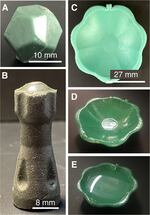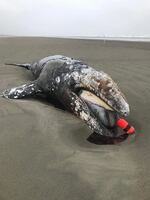In this monthly rundown from OPB, we feature the most interesting, wondrous and hopeful science coming out of the Pacific Northwest, from Jes Burns, creator of “All Science. No Fiction.” And remember: Science builds on the science that came before. No one study tells the whole story.

This image released by Washington State University shows a 1/6-scale astronaut after dust application (left); after dust application and treatment in a vacuum (center); and after dust application, treatment in a vacuum, and spot treatment with a handheld liquid cryogen spray (right).
Courtesy of Washington State University
Moon dust spray
Moon dust is some unpleasant stuff. It’s comprised of silicate, which causes lung disease in miners on Earth, and it’s real sticky because of static cling. The dust has wreaked havoc for astronauts in the past — causing “lunar hay fever” and damage to gear. With NASA targeting the next moon landing for 2025, scientists are looking for ways to get rid of the dust.
Researchers at Washington State University have found a way to remove more than 98% of the dust on coated mini-astronaut dolls tested in a vacuum in the lab.
They used a liquid nitrogen spray (so cold!), which essentially boiled when it hit the warmer surface of the proxy space suits. This action caused the dust to lift off the material surface and float away on the nitrogen “steam.”
In addition to being more effective at dust removal than the brushes and vacuums used by the early moon explorers, the researchers say the liquid nitrogen also does far less damage to the suit material.
Read the study in the journal Acta Astronautica here.

This photo from Boise State University shows multiple injection-molded objects created from a new isomalt-based plastic substitute.
Courtesy of Boise State University
Oh, sugar forks!
Single-use plastic is everywhere, and it’s actually pretty difficult to get around using it completely. Despite how bad this stuff is for the environment, we really haven’t found an alternative that’s caught on.
But researchers at Boise State University have developed a new material they think could help solve our single-use woes. The material is made of a sugar called isomalt — the glory of baking shows everywhere — with additives of cellulose (from plants), sawdust or wood flour. The additives boosted the strength of the normally-brittle isomalt.
The result is a substance that’s harder than plastic, lightweight, and quickly dissolvable in water. The researchers then experimented with a food-grade coating that would keep the material from dissolving when wet. To recycle, just crack the coating.
The bonus is that the material can be dissolved and reformed into new items without loss of strength. And for those errant forks that end up on the ground: the authors say the dissolved material could actually be beneficial to soil.
Read more in ACS Sustainable Chemistry & Engineering here.
Building better batteries
To get to 100% renewable energy — with energy sources like solar and wind that aren’t making electricity around the clock — we’re going to have to be able to store electricity on the grid to use when nature isn’t making enough. The best batteries available at this point are lithium-ion batteries, but they’re spendy, mining lithium can be fraught and some of the chemicals involved are toxic.
The quest for the next big thing in batteries is ongoing, and researchers at Oregon State University are focusing on zinc. Zinc batteries have the potential to be safer and cheaper for the grid, but it’s been difficult to create a version that recharges efficiently.
The OSU researchers have developed a new electrolyte (the liquid or paste-like solution in batteries) that allows the battery to charge and recharge with virtually no loss of energy. The electrolyte also solves some of the common safety issues related to zinc batteries.
The scientists say the breakthrough represents a critical step forward in getting zinc-based batteries on the market.
Read the article in the Journal Nature Sustainability here.

In this photo provided by Xiulei “David” Ji, shows wind energy generation.
Courtesy of Xiulei “David” Ji/OSU College of Science
Yellow fever cure?
Yellow fever is a pretty nasty disease spread by mosquitoes in the tropics of Africa and South America. As the name suggests, sufferers can start to appear yellow with jaundice. There’s a vaccine, but no cure if someone gets infected. And the impact of the disease is only expected to get worse with climate change.
But a team including researchers at Oregon Health and Science University are testing a new treatment that is showing great promise. They’re using a medical technology called monoclonal antibodies, lab-made proteins that help your immune system ward off infection (and probably best known for their role as a COVID treatment).
In animal tests, hamsters and monkeys infected with yellow fever showed no signs of infection after receiving the treatment. Two different strains of monoclonal antibodies were tested with similar success.
Mabloc, the company leading the development of the treatment, will use these results to inform a future clinical trial on humans.
Read the paper in the journal Science Translational Medicine here.

This photo by NOAA Fisheries shows a stranded gray whale with a crab pot line.
Courtesy of NOAA Fisheries
Untangling the ocean
Over the past few years, hundreds of whales have been found tangled in commercial fishing gear off the West Coast. Scientists believe the actual number of entanglements is much higher. Steps have been taken to reduce this number, but whales are still getting caught up.
Now researchers at Oregon State University and the Oregon Department of Fish and Wildlife are looking to science in hopes of reducing the chances of entanglement. The scientists overlaid 10 years of population data for humpback and other whales off the Oregon coast with Dungeness crab fishery logbook data. They then looked at when and where the two groups were most likely to cross paths.
Climate conditions (like marine heat waves and upwelling season) seemed to drive the most risk of conflict as whales looked for food closer to shore.
ODFW says it will use the new analysis to (possibly) tweak commercial crabbing rules to reduce the chances of that much larger — and decidedly unwanted — catch.
Read the paper from the journal Biological Conservation here.
